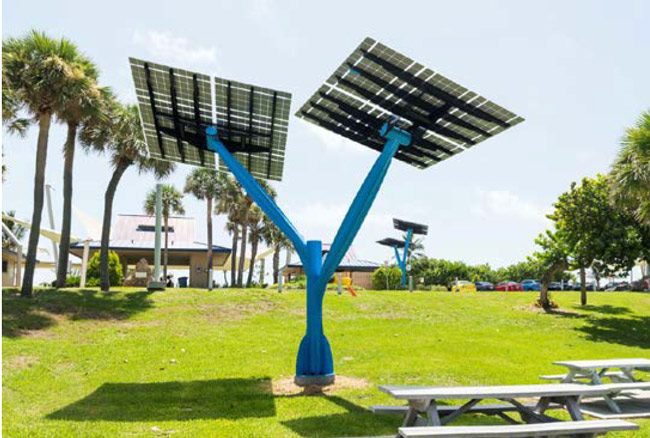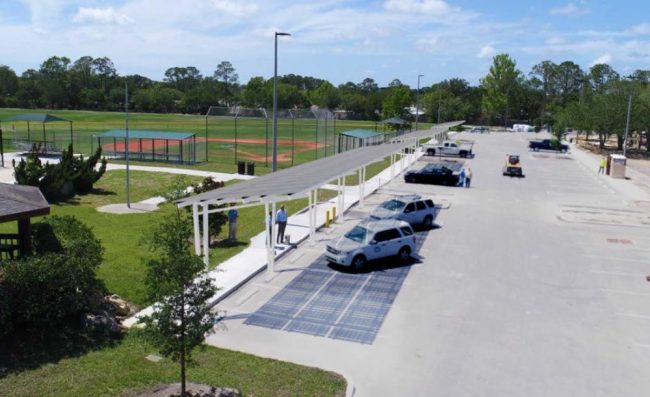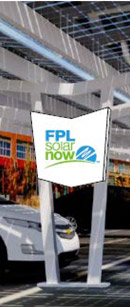
Assuming the Palm Coast City Council approves the deal Tuesday, you’ll soon start seeing a few odd looking structures on city property: five “tree”-looking solar panels at Central Park in Town Center, and solar canopies, providing shaded parking spots, at Holland Park, the Community Center and at City Hall. The projects will start going up later this year or next year.
The Palm Coast City Council has not discussed the matter previously, so its members were not aware it was coming before them, as the item will for approval at next Tuesday’s meeting. It was scheduled to be discussed at this week’s workshop, which was cancelled for lack of a quorum.
The item is being framed within a presentation Florida Power and Light has presented to a few local governments in the state, presenting essentially the same PowerPoint presentation while customizing a few images. The lease agreement FPL then submits to local governments follows the same parameters and language, customizing it to each locality. (The city of Stuart went through an almost identical process earlier this year when it approved one such canopy installation.)
It’s part of Florida Power and Light’s “SolarNow” program, which gives the power company a chance to advertise its solar initiatives (the installations include prominent, promotional logos of the company) at no direct cost to the city, though the city would be leasing to FPL for 15 years portions of property where the devices are installed.
It’s a way for a community to show that it “values sustainability, and values solar energy,” an FPL spokesperson said. “It’s a great way for folks to see what solar looks like up close.”
Beyond giving FPL a chance to stamp its brand on public property for many years and appear to be at the vanguard of renewable energy (it isn’t: though it is Florida’s leading power company, Florida ranks 13th in solar generating capacity in the nation and 18th in solar installations, according to the National Renewable Energy Laboratory), the public benefit is not as clear.
In exchange for the three solar installations on its grounds, the city would get modest perks, beyond bringing awareness to solar power: the canopies will generate shade for cars and a rent payment of $18 per kilowatt per year (the aggregate will be no more than a few thousand dollars per year), and the trunks of the solar power “trees” will have electrical outlets that will serve as charging stations for park-goers’ phones and tablets—a service the city could provide at little cost to itself.
“One of the points they asked was they wanted a high volume traffic of people because it’s supposed to encourage solar awareness,” Denise Bevan, a city administration coordinator and Palm Coast’s point person in working out the deal with FPL, said of the three locations chosen for the installations. There is a possibility of expanding installations, but that will depend on funding. (See the lease documents here.)
The electricity generated by the installations goes into FPL’s grid and gets redistributed to customers. It does not appreciably lowers costs: if all installed devices generate 350 kilowatts, FPL officials told the Public Service Commission when originally presenting the project, it would provide a $19,000 fuel saving to customers for the year—across the state, or less than a third of a penny per year.
There are currently nine SolarNow installations across the state, generating 400 kilowatts, according to FPL. So the fuel saving to customers may be up to half a penny per year at most. (The installations are at Babcock Ranch Preserve, Boynton Beach Oceanfront Park, Brevard Zoo, Frost Museum of Science, Palmetto Estuary Preserve, Palm Bay City Hall, Palm Beach Zoo & Conservation Society, Tropical Park, and Young at Art Museum and Zoo Miami.)

Those costs are born by FPL customers who participate in the revenue-generation part of the company’s SolarNow program: any FPL customer may voluntarily elect to add $9 to his or her monthly bill to be part of that program. There are no direct benefits to customers for patrticipating other than the feel-good notion of “helping to support the development of solar energy projects in local communities,” as FPL describes it—projects like those that may go up in Palm Coast.
FPL spokesperson Lisa Paul said 256 customers in Palm Coast participate in the program, and 21,000 do so across the state. That generates $2.27 million a year (more as additional customers join), which is used to build SolarNow projects.
“We don’t make any money on this, we don’t make any profits, and we offset any profits by donating to charity,” Daly said.
The numbers don’t appear to bear out Daly’s assertion: The program has been in effect three years. With a total, current capacity of 400 kilowatts, the cost to build the installations—based on FPL’s estimates to the PSC—would have run around $1 million. She said another 380 kilowatts’ worth of projects are in the pipeline, which would bring the capital cost closer to $2 million over three years, though the program’s $9-a-month participants generate $2.27 million a year. The donation to charity amounts to $200,000 a year.

“So, again,” Commissioner Lisa Edgar asked FPL officials, “what’s the connection? I’m sorry. I’m just, I’m missing it. I just don’t — allowing certain participants to vote on where FPL puts some of its charitable funds, what does that have to do with a $9 voluntary contribution?”
Customers “who might be interested in solar programs may also like the additional incentive to also receive those monies to contribute to environmental type of organizations,” was FPL’s Maria Moncada’s answer.
Renewable energy advocates were not convinced by FPL’s initiative when submitted to the PSC. “While the proposed FPL program is not intended to install solar PV on any meaningful level,” Charlie Coggeshall of the Southern Alliance for Clean Energy wrote the PSC, using the abbreviation for “photovoltaic,” “if it was better designed and more ambitious in scope, it could be a legitimate tool in building solar energy capacity in Florida. In its present form, it’s merely a feel-good, green-pricing program, which does not provide direct and tangible benefits to participating customers.”
The commission in the end approved the initiative, but against some opposition even from those who wholeheartedly approve of renewable energy.
“I want to go on record as saying that I am fully supportive of innovative efforts to bring more renewables to our fuel portfolio, and I know that as a Commission we will continue to look at those issues broadly,” Edgar, the public service commissioner, said, explaining her opposition. “I am, quite frankly, a little stunned at the lack of answers that I’ve been given today, and I do not have the comfort level that I would like to have as to how the program is going to be marketed and promoted and targeted. I think that’s a very important piece of it. And to ask us to bless a program that you don’t even know if it’s cost-effective without telling me how you’re going to reach out to consumers and explain it to them is just something that gives me some discomfort.”
The seeding of such installations as Palm Coast’s, with its logos, and tie-ins to the $9-a-month participants (who would get some form of recognition, according to FPL’s presentation) appears to provide just such a marketing and promotional component, though Daly, the FPL spokesperson, bristled at the suggestion, insisting that “signs” showing the company’s logo are not free advertising, and that the program’s sole intent is to bring up-close awareness to solar power.
![]()
The FPL Presentation to Palm Coast City Council
Click to access fpl-presentation-1.pdf




























Mark says
Why deprive the grass of it’s needed sunlight?
Wishful thinking says
Sounds like a lot over blown impractical useless Bill crap to me. How about You?
SunSon says
Here comes the sun, here comes the sun,
And I say it’s all right
Little darling, it’s been a long cold lonely winter
Little darling, it feels like years since it’s been here
Here comes the sun, here comes the sun
And I say it’s all right
Little darling, the smiles returning to the faces
Little darling, it seems like years since it’s been here
Here comes the sun, here comes the sun
And I say it’s all right
Sun, sun, sun, here it comes
Sun, sun, sun, here it comes
Sun, sun, sun, here it comes
Sun, sun,…
– George Harrison
Lou says
UGLY, UGLY AND UGLY
Who will be carrying the related liability insurance, the city or FPL?
In the Dark says
Illusion and confusion from fpl.
I have solar power to sell
but they tell me to go to hell.
Rich says
FPL should stop its opposition to net metering on solar installations for its customers.This is the only way solar use can grow in Florida.
Born and Raised Here says
Anything to save energy, and lower cost, I’m all for it.
marc KAPLAN says
Solar electric can be practical. This project is not. Should be canned.
Alphonso Zeimers says
In the Dark and Rich, you both had comments that were dead on.
YankeeExPat says
I’m a big fan of renewable’s, but the aesthetics are all wrong. It looks like a giant BIC razor.
thomas says
PC government never ceases to amaze me. This is ridiculous.
Pogo says
@YankeeExPat
I’m with you. The design makes me think FPL is taking a dive – losing on purpose. But they wouldn’t do that – they’re just another monopoly doing what’s right – right?
palmcoaster says
True: https://www.youtube.com/watch?v=GwmVfewqu7I
Is a step in the right direction…In spite that not a given structure is going to please all the time, like nothing is
Now next we need to demand our Tallahassee legislators to come up with a Florida referendum of the people to support that anyone that has the upwards $40,000 to install solar in their houses can undo FPL opposition to net metering on solar installations for those solar paneled customers.
Stranger in a strange land says
This is a public relations effort to help in their fight against net metering. If you want to know what is really going on read this article. http://www.newyorker.com/magazine/2015/06/29/power-to-the-people Net metering is viewed as a threat to utility companies. The idea of a house with solar panels and a battery storage system that allows the owner to sell excess power to the grid sends chills down the spine of Utility executives. Luckily, voters saw through the misleading constitutional amendment on the November 2016 ballot that would have thwarted independent solar installations. Utilities will try again and I guarantee this grandstanding of their “solar friendliness” will be used as propaganda to promote another misleading bill to protect the utilities. Traditional utilities are like dinosaurs except they can see the meteor of technological advance streaking towards them, threatening them with extinction.